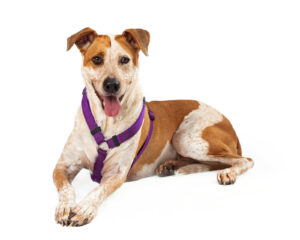Barks Blog
Ask the Dog!
By Ada Simms

/adogslifephoto
Many dog trainers and dog owners probably have a closet full of front attaching or no-pull harnesses. It shows that our interest is about the dogs and their comfort, therefore we experiment. Could we find one that goes on easier or one that provides more control yet is still comfortable for the dog?
As I thought about whether I should use brand names or not for this article, I came to the conclusion I would not be doing justice to the companies that I have not bought from or with which I am not familiar. My view is strictly from a dog trainer’s point of view and experience with clients’ dogs.
The first question concerns the benefits of using a harness. I consider whether the dog would benefit, the handler or both. With puppies, I request a harness that fits the puppy appropriately. At this young age, and usually small size, a back-clip harness will do for class and walking the puppy. A collar is recommended only to hold the dog’s ID tags. I do not like any pressure on the dog’s neck because of possible injury to the neck.
Inevitably, new students want to use a flat collar. For the first class I do allow this, but if the puppy or dog is straining against the collar, pulling the owner, or the dog is panting/choking, he must have a harness. I have yet to see a puppy that can pass this “test.”
Conversely, there have been a few times where a dog did not pull after the harness was put on. Training to walk on a loose leash and a no-pull harness makes for a happy client who sees the results much quicker.
Which Harness?
Harness with Straight Chest Strap
There are two types of no-pull harnesses that are prevalent: those with a chest strap that goes around the chest (horizontal) to the ground with a loop in the center and those that have a Martingale action on the front or the back along with two points of connection (chest and back). This is where the fit part comes in along with the body structure of the dog, and observing the dog.
I find narrow chested dogs, including my own dogs, find these harnesses uncomfortable. No matter how I adjust them, the girth ends up right behind the front legs causing chafing. My dog informed me of this by scratching at it with her hind leg. My other golden retriever with good conformation and a big chest wears them well and is very comfortable.
How the harness fits or does not fit is a big concern. When I see dogs out in public with a no-pull harness I am initially thrilled but then I notice sadly that the chest strap is too low, hindering the shoulders and the motion of the front legs.
If I have an opportunity I mention to the person accompanying the dog that it should be higher and fit a bit tighter so it does not constrict the dog’s movement. The answer I usually get is, “[He/she] will grow into it,” and that they did not want to spend money on two harnesses because the puppy will grow. I try to add a little humor and tell them I know too well how that feels.
In September, right before school started, I picked out one pair of shoes and one pair of sneakers but I had to buy at least a half size bigger because my feet would grow. Those two pairs of footwear had to last me the whole school year. I did not run well in gym class and my shoes would fall off my feet.
Walking, stride and rhythm are very important for developing growing muscles. We would not even think about doing this for a growing child these days but money was tight back then. Somehow this little story makes sense to them. At least it gets them thinking about the investment of a properly fitted harness.
Harness with V-Shaped Chest Strap
Within the last six months, I bought several harnesses with this V-shaped chest strap configuration. These harnesses fit my thin-chested golden retriever because the strap sits high, just below the neck, with another strap connecting the V that goes underneath the front legs, under the chest and connected to the back strap. All three harnesses fit her perfectly and she is happy with all of them.
I especially liked two harnesses that had adjustments on each strap to make it smaller or larger, ensuring a good fit. There was no more chafing behind the legs since the harness straps behind the front legs were set farther back and did not interfere with her movement.
Which harness to buy with so many choices in the market is best answered by each individual trainer – and remember to ask the dog too! As I have said, one of my dogs was comfortable in any harness I put on him. I do prefer a back and chest connection for the leash. For big pullers, two areas of control by attaching the leash to both is a great option.
When I want my dogs to walk loose leash, by my side, I attach the leash to the front chest ring. This tactile cue means just that… stay with me. When we go for a walk where they can explore, scent tracks or run (with their “be a dog” time), I have a 30-50-foot leash connected to the back strap.
My dogs also have a cue, which I use if they are getting to the end of the leash, to change direction. Two golden retrievers dragging me along would not be pretty. I conditioned the cue, “This way!” which means I am going in another direction so turn around. I always reinforce this with a treat or start running so they can play the “catch up” game.
When purchasing a harness, find companies that will take returns if it does not fit correctly. Leave the tags on if possible. Most local pet stores do not sell the V-shaped neck harnesses, also known as “H” harnesses with front leash attachment ring. These have to found online. Many have videos that instruct you how to measure your dog to find the correct size and also how to use the harness.
Do train your dog that staying with you and not pulling is the most reinforcing thing ever. If the leash is tight from your hand to the dog, do not move forward. You cannot start this soon enough. Be the “cookie” for your dog so that you are more interesting than the environment.
“Naked” dog training without any collar or harness should be practiced in the home or a secured area. If the dog is not working with you, you will know that you need to up the reinforcement and make it fun.
The harness is a tool to be used in tandem with training loose leash walking techniques. Outside, use one of these types of harnesses combined with positive reinforcement methods so that the walk, over time, will be enjoyable for both.
Resources
Properly Fitting a Harness
Wrongly-Fitted Harness by Lori Stevens
This article was first published in BARKS from the Guild, March 2015, pp.36-37. For more great content on all things animal behavior and training, you can sign up for a lifetime, free of charge, subscription to the digital edition of BARKS from the Guild.
About the Author
Ada Simms CPDT-KA OSCT is the owner and trainer at Reward That Puppy Dog Training Inc. in West Henrietta, New York, where she conducts classes and private sessions. She has earned titles in obedience and agility with her two dogs.

